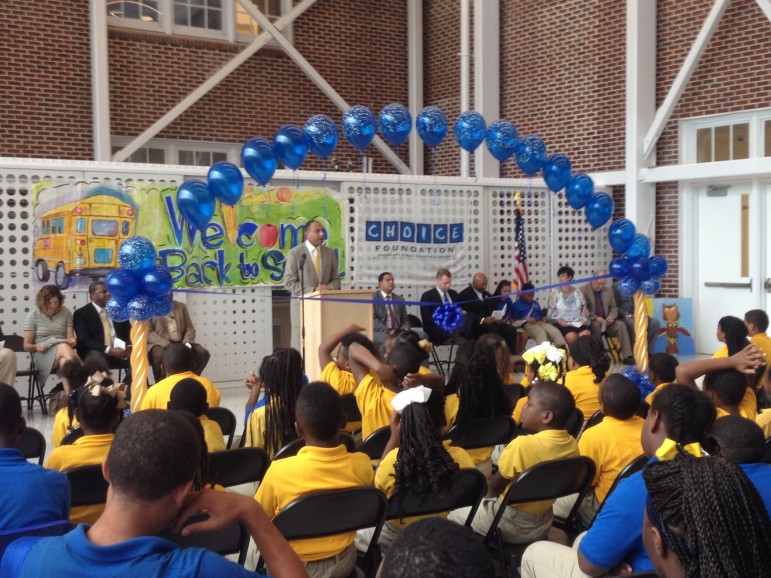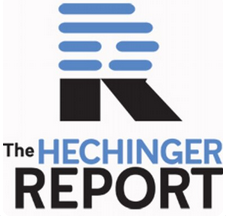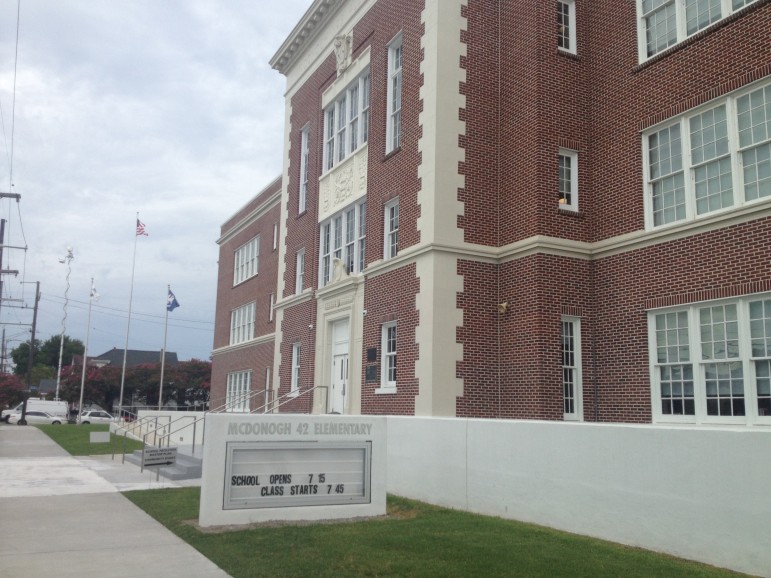
A long, blue ribbon with a giant bow graced the front of McDonogh 42 School’s packed cafeteria at its reopening ceremony last week. In front of quiet, yet slightly squirmy elementary students, Recovery School District Supt. Patrick Dobard recalled attending kindergarten at the Treme school years ago.
“I ended up spending all of my formative years in this neighborhood,” Dobard said. “This is a very personal experience for me with that background.”
It’s a good day when new and refurbished schools such as McDonogh 42 “are no longer the anomaly. They are now like the norm,” Dobard added.

There’s no shortage of people trying to analyze how much the New Orleans system of schools has improved academically since Hurricane Katrina struck 10 years ago, a nearly impossible task. But the physical recovery and rebuilding of neighborhood anchors, a multi-year $1.8 billion venture, is easier to measure.
McDonogh 42 is one of more than 80 sites in New Orleans’ school rebuilding plan. Each has a slightly different recovery story, and several are opening and reopening this fall as the city this week commemorates the 10th anniversary of the storm, which left poorly performing city schools physically battered.
An August report shows 19 new schools have been completed, 13 are under construction and 3 are upcoming. Thirteen buildings have been or will be renovated. Another 29 are being refurbished.
Some schools were renovated. Others sit empty, boarded up still. A handful were razed and rebuilt. Some were knocked down and the land now stands empty.
But with a student population markedly lower than when the storm hit in 2005, they aren’t all needed and weren’t included in the plan. Some schools were closed forever and demolished.
CAMPUSES WIPED OUT
“SCHOOLS IN DISARRAY” a Nov. 20, 2005 headline in The Times-Picayune read.
The story detailed building damage, 300 totaled — and underinsured — buses, and “grossly negligent” record-keeping that could only complicate the Orleans Parish School Board’s insurance claims.
Of the 117 schools in operation the previous year, 40 percent, or 47 schools, were severely damaged, according to the article. Thirty-eight were said to have moderate damage, including McDonogh 42, and the remaining 32 has light damage or were nearly unscathed.
It would require massive resources to clean up the debris and mold-riddled homes, and rebuild the city, along with its school system.
Public school did not restart in Orleans Parish until mid-December. That’s when the newly formed Algiers Charter School Association opened its schools for half-days, more than three months after Katrina struck. That part of the city did not flood.
As families began to return, the majority of schools opened under the Recovery School District and others under newly chartered nonprofits. Many reopened in January for a partial year, re-registering students and generally opening up unclaimed seats to students without open schools.
At the end of the 2005-06 school year, 12,000 students were enrolled, a fraction of the 65,000 enrolled the year before the storm. The next year, enrollment nearly doubled. In 2013-14, the city had over 46,000 students enrolled in public schools, and the rebuilding effort is designed to handle 55,000.
A PLAN TO REBUILD
In 2008, the districts adopted a school facilities master plan, intending to build over 30 new schools and renovate 50 more.
In 2010, FEMA offered the RSD and the School Board a $1.8 billion settlement that has fueled a majority of the rebuilding. Schools have also tapped into historic tax credits by selling them to third parties.
McDonogh 42’s renovation represents a middle-of-the-road recovery story.
The school reopened in early 2007 under direct control of the RSD and helped bring relief to the pressure of a 300-student waiting list citywide. That summer, Treme Charter School Association assumed operation of the school and it opened in the fall as a charter.
After five years of operation, the state Board of Elementary and Secondary Education voted not to renew the association’s charter and the school was taken over by Choice Foundation, a charter management organization with two other campuses.
Choice ran McDonogh 42 at its original site for a year and then moved for two years to a temporary modular campus in the Desire neighborhood, about three miles away.
Time on temporary campuses and in modulars is not uncommon for New Orleans students.
The master plan includes a lot of hop-scotching for schools as they make their way to permanent facilities. Some, such as Morris Jeff Community School, spend time in private facilities that they rent before landing in a new home. Morris Jeff moved into the new Fisk-Howard building this year after three moves in five years.
Even as several schools have ribbon cuttings in the coming weeks, the School Board is still making decisions on its vacant and surplus properties, which are becoming more valuable as enrollment grows faster than anticipated.
This month, the Orleans Parish School Board unexpectedly halted an auction of surplus properties.
Among them is McDonogh 19 School, integrated by three girls the same day Ruby Bridges was ushered to William Frantz Elementary by federal marshals, a scene memorialized by Norman Rockwell.
CITIZENS RECOMMIT MONEY FOR SCHOOLS
Voters recently renewed their commitment to the schools in a December election where they approved a $150 million tax dedicated to New Orleans public school facility maintenance for 10 years. That’s good news for McDonogh 42 and all city schools, which will see a per-pupil allocation of that money depending on their enrollment.
Dobard reminded the audience of students, staff, community members and elected officials Wednesday that they needed to instill a sense of responsibility in the community and keep schools in good shape for generations to come.
Like others now, McDonogh 42 is adorned with two plaques: one from 1925, when the school was built, and a current one.
The new plaque reads, in all capital letters:
“On August 29, 2005, McDonogh 42 School was destroyed by floodwaters from the levee breaches during Hurricane Katrina. The government of the United States of America funded the rebuilding of this school. The citizens of New Orleans thank all Americans for supporting the children of this great city.”

